Healthy Posture for Better Sleep
Signs of good sleep include taking less time to fall asleep and not waking up often or for long periods. And although the American Academy of Sleep Medicine (AASM) and the Sleep Research Society (SRS) recommend adults sleep at least seven hours a night,¹ over one-quarter of us fall short of this recommendation.² There are many factors contributing to this lack of sleep, and back pain is certainly one of them.

When I had herniated my disc, it was the most sleep-deprived time of my life. I recall regularly walking around the block during the night, just to ease my back spasms enough to catch a few more hours of sleep. That was long before I knew the measures the Gokhale Method® now teaches to reduce such pain, accelerate healing, and prevent recurrence. For anyone in that situation, techniques like stretchlying and inner corset are no-brainers!
But the most common—and most under-recognized—reason for our tossing and turning and sleep deprivation is less dramatic than a herniation, or even pulling a muscle. The numerous microaggressions that our bodies suffer during the day due to poor posture, predispose you to a nighttime beset by jangled nerves, tense muscles, and areas of inflammation. This is disruptive to both mind and body, especially in the hours when you want to rest and rejuvenate.
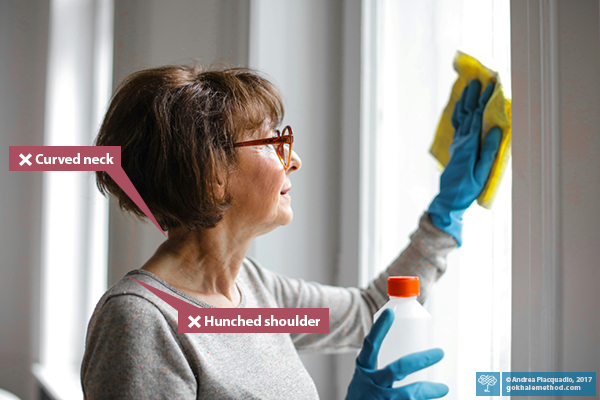
Poor use of our body during the day can unwittingly store up nighttime aches and agitation. Image by Andrea Placquadlo, 2017
Will the right mattress help me sleep?
In much of the world people sleep on the floor, often on just a throw or thin bedroll. In hot countries the floor is often the coolest place to be, and if your culture generally enjoys healthy posture and a low prevalence of back pain, lying on the floor can be perfectly comfortable. Most people in industrialized and postindustrial societies, however, have not preserved natural length, shape, and health in their spines, and therefore require more support and cushioning from their bed.
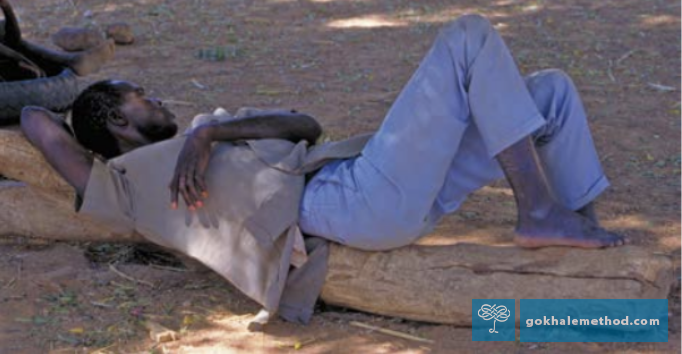
A lengthened, supple spine can tolerate even an unforgiving surface, such as this log.
The most important thing to avoid is a sagging mattress or bed springs that let your spine fall into a compressive curve. As a general rule, the greater the number of springs/coils a mattress has, or the better quality the memory foam (some mattresses have both springs and a foam topper), the better the support you get for your weight and contours. However, I have known many people pay handsomely for mattresses that promise a lot but deliver little, so I recommend taking advantage of “try before you buy” deals.
I have also heard from many of our students over the years that their existing mattresses have, to their joy, become comfortable. In other words, as their posture has improved, more naturally aligned bones, relaxed muscles, and appropriately spaced discs and nerves, are happy at last. Their body is now comfortable, and their brain is no longer waking them to tell them something is hurting—insomnia resolved. One student reported that having learned the Gokhale Method she even said goodbye to a lifelong recurring nightmare!
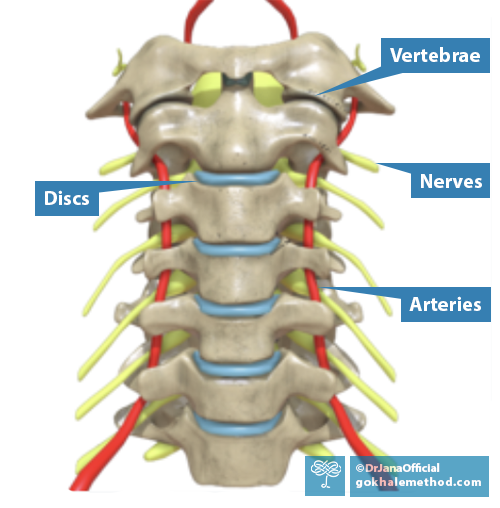
There are many delicate and vital structures within the spine, as shown here in the neck. They require healthy alignment and length, rather than compression, to be happy (front view). Wikipedia
What is the best sleeping position?
In addition to healthy posture and moving as you are meant to during your daily activities, there is a lot you can do at night to arrange yourself well, encouraging muscle relaxation and improved circulation for healing. Comfortable sleep is sometimes the first place that you can break a pain cycle and start to mend.
The Gokhale Method offers two main techniques for transforming your sleep: stretchlying on the back, and stretchlying on the side. These are taught in detail in our in-person Foundations course, and online Elements course. You can also learn all the steps involved from my book, 8 Steps to a Pain-Free Back, or DVD, Back Pain: The Primal Posture Solution. You can get started with our free Gokhale® Moment video (below) for stretchlying on the back.
No special equipment is required for stretchlying—just learn the principles and moves involved, and how to arrange your pillows accordingly.
One breakthrough for many people is to use a pillow under the knees when lying on their back. This accommodates a tight, shortened psoas muscle, rather than let it pull on the lumbar spine. Though this pulling sometimes goes unrecognized at night, it can result in a back so stiff the following morning, it can be hard to move or dress yourself.
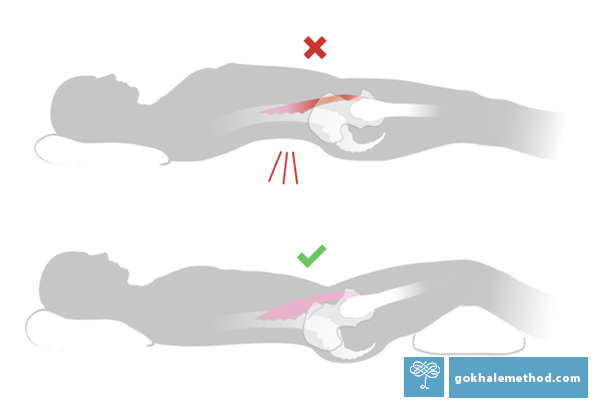
Placing a pillow under your knees when lying down accommodates tightness in the psoas and avoids pulling on the vertebrae and surrounding tissues to which it is attached.
Snoring and sleep apnea
Snoring elicits reactions ranging from hilarity to fury. It can be transitory, due to a cold, for example, but persistent snoring can be embarrassing for the snorer and disruptive for others. Snoring may also be a precursor to other breathing and health problems; if you snore, you might benefit from working with a health professional.
From a postural viewpoint, some overly tight muscles, including the psoas and the erector spinae, will contribute to arching your lower back or pulling your head back. The resulting additional weight from your throat and tongue on your airways could give rise to mouth breathing, thus aggravating both snoring and sleep apnea.
The gentle sloping arrangement of the pillows in stretchlying, combined with lengthening of the neck, helps to keep the airway clear and well aligned downward, reducing symptoms. This is helpful both when the condition is mild, and also when a CPAP (Continuous Positive Airway Pressure) machine is used. Our techniques can also be adapted with extra pillow elevation, and the side-lying position is of particular help with breathing difficulties.

Antique tomb sculpture shows how people positioned their pillows in earlier times—without sway in the back or neck. (Öhringen church, Germany.)
Best next action steps
If you would like help with your sleeping positions, get started by booking a consultation, online or in person, with one of our teachers. Sweet dreams!
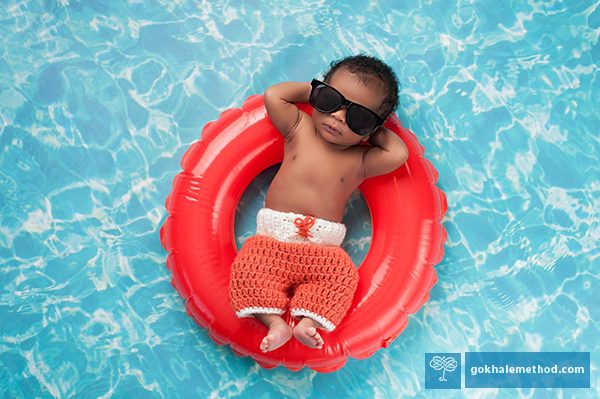
With the right help, we can all relax to sleep—like a baby!
References:
¹ Watson, Nathaniel F., M. Safwan Badr, Gregory Belenky, Donald L. Bliwise, Orfeu M. Buxton, Daniel Buysse, David F. Dinges, et al. 2015. “Recommended Amount of Sleep for a Healthy Adult: A Joint Consensus Statement of the American Academy of Sleep Medicine and Sleep Research Society.” Journal of Clinical Sleep Medicine 11 (6). https://doi.org/10.5664/jcsm.4758.
² “QuickStats: Percentage* of Adults Aged ≥18 Years Who Sleep <7 Hours on Average in a 24-Hour Period,† by Sex and Age Group — National Health Interview Survey,§ United States, 2020.” 2022. MMWR. Morbidity and Mortality Weekly Report 71 (10): 393. https://doi.org/10.15585/mmwr.mm7110a6.
You can sign up below to join any one of our upcoming FREE Online Workshops…

Comments
Add New Comment
Login to add commment
Login